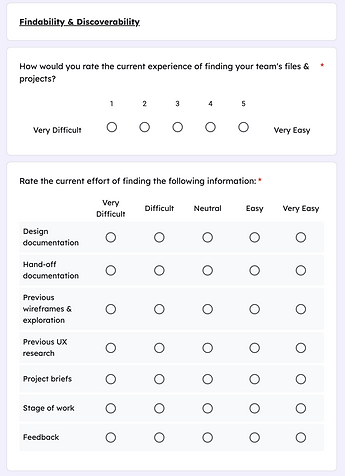
HubSpot Figma Migration
HubSpot is a CRM platform used for inbound marketing, sales, and customer service.
During my 2022 internship with HubSpot, the Brand and Creative teams were in the beginning stages of their design system migration from Sketch to Figma with the goal of driving more design flexibility and collaboration across UX/UI Designers, PMs, Art Directors, and Developers.
To support this goal, I completed the following projects:
-
Synthesized findings from a Creative Solutions team workshop
-
Designed templates for Figma cover design and file structure
-
Created surveys to measure progress and satisfaction of the migration
Role / UX Research, Design System, Project Management
Task / Support a design system migration and reveal opportunities to improve the Brand and Creative teams' internal design process
Duration / 3 month internship
Tools / Figma, Sketch, Asana, Jira
Workshop Synthesis
From all of these useful insights, I gave the team recommendations for next steps in the migration that will empower them to achieve the superior standardization, collaboration, and control they are seeking from Figma that Sketch cannot provide:
Expectations for the migration /
-
Documentation templates
-
Ability to design, prototype, and comment in one place
-
Ability to quickly and easily find everything related to a project in one place
-
Easier collaboration
-
Standardized feedback
-
Version control
What came next /
-
Figma cover designs
-
Standards and templates for Figma page organization
-
File saving system in Figma
-
Improvements to templates & documentation in 'Tactical' areas
-
More collaboration
Cover & File Structure Templates
A lack of standardized templates was a common pain point identified in the previous workshop, so I created templates for file covers and pages to improve discoverability.
I conducted a follow up workshop with the Creative Solutions team to better understand how designers want file pages to be organized and how they use thumbnails. This collaborative process enabled the UX and UI designers to contribute to the new Figma standards.
Final Template /

Surveys
I measured the success of this migration through a survey for designers and developers.
First, I identified and defined the following metrics that the survey should capture:
-
Discoverability / average amount of time to find info
-
Collaboration / file sharing, comments, feedback for design reviews, and dev handoff
-
Efficiency / average amount of time to create designs
-
Satisfaction / net promoter score (NPS); specific to the internal design process
-
Engagement / amount of time to fully embrace Figma & stop using Sketch
Next, I consulted a UX researcher on the team who helped me fine-tune the Likert scales and survey language to avoid any biases.
The final step was creating a survey schedule. I decided that 3 rounds of surveys sent out 6 months apart would provide the best indicator of the migration's progress from designers' and developers' perspectives. This would ultimately inform whether more support was needed or if there were any missed opportunities for improvement in the migration process.
Here is a sample of Round 1 of the survey for designers & developers:
Learnings
Organization is everything
01
Using Jira and Asana, card sorting activities, and feedback categorization ensures that all details are captured during this transition phase.
Lean in to feedback
02
While receiving feedback and edits from stakeholders can be cumbersome, an open line of communication contributes to a better
end product.
Language
matters
03
Always ensure that surveys are free of biases and that workshop instructions are clear to avoid confusion.


